 |
|
Shipcraft
|
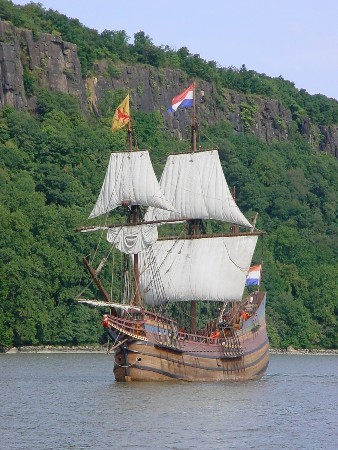
|
Quicklinks:
Rope Handling
Charting Position
Working in the Rig
Craftworks
Music |
| Although we do have some modern amenities
onboard the replica Half
Moon, we still sail and maintain our ship in much the same way
Hudson's crew did in their day. Operating the Half Moon
can require tasks that take the crew from the very top of the rigging
right down to the bilge.
|
| Rope Handling
We have nearly three miles of rope onboard the Half
Moon, and every line performs a specific task. Thus, literally
"learning the ropes" is one of the first and most central
challenges for any new crewmember.
|
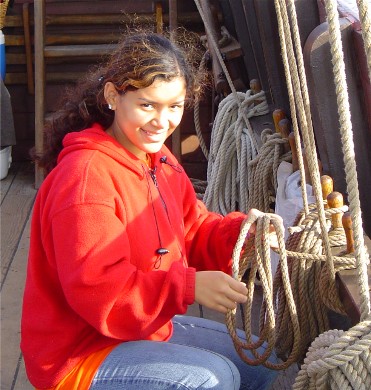
|

|
| First, the new crew
learns how to properly coil ropes and belay them securely on the pin
rail, as Laila and Nora demonstrate above. It's a simple job but an
important one. Coiling ropes clears them from the deck, preventing the
formation of tangled piles that could otherwise snag people's feet or
snarl nearby lines.
|
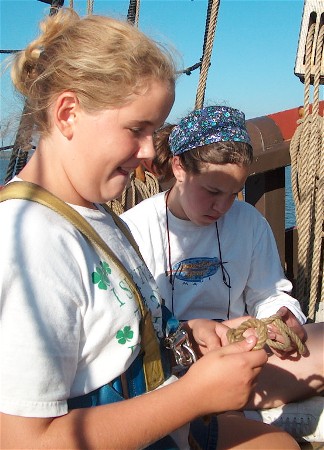
|
Now that the crew knows how to
tidy the ropes, it's time to learn how to tie them. Like the lines
themselves, there are scores of different knots a crewmember can learn,
each one best suited to a specific role.
Students such as Nicole and Samantha (left)
begin by learning the basics: the square knot, the sheet bend, and the
bowline knot (and sometimes even the tricky one-handed bowline). These
three knots can take a crewmember a long way.
|
| Once they've learned how to handle
the ropes, the crew needs to learn each line's role in working the
sails. The students may not know a clew from a bunt from a sheet when
they first come on board, but they're soon ably using the lines to set
the sails, brace them to the wind, and much more.
|

Back to Top...
|
| Charting Position
|
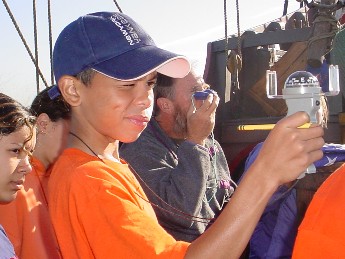
|

|
| The student crew
learns how to read charts of the Hudson River, even comparing our
modern charts to those from the 17th century. With that knowledge in
hand, students like Abel can find surrounding landmarks and use a hand-bearing
compass
(above left) to accurately triangulate the ship's current position.
Back to Top...
|
| Working in the Rig
Some of the most thrilling opportunities onboard
the Half Moon await high above its weatherdeck. Many
crewmembers climb the rigging as part of their duties, whether it's to
work the sails or just to rescue a snagged flag.

Safety is of utmost importance onboard the Half
Moon. Before anyone -- including both students and adults -- is
allowed to climb the shrouds (the black, ladder-like rigging to either
side of the ship, above), they must pass a climb test. Under experienced
crewmembers' close supervision, the new crew learns the proper methods
of safely wearing and using a safety harness.
Above, you can see some of our new crew being
escorted up into the rigging under the watchful eyes of Mr. Meilick, Ms.
Oosterloo, and Mr. Mangrum, who are all making sure they keep every
safety guideline in mind. To complete their climb test, the new crew are
asked to hang from just their hands for a few seconds, giving them a
feel for how much strength they need to support their own weight in
case of an accidental slip.
|
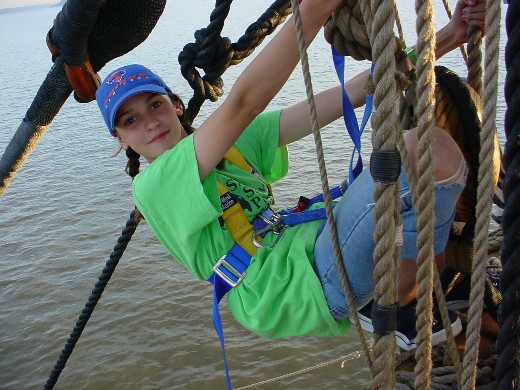
Once crewmembers pass the climb test, they're qualified to work in the rigging.
Nora (above) may appear to be in a precarious position,
but she's quite secure. She's heeding
everything she learned in her climb test: Her safety harness is securely
clipped in and she's obeying the three-point-contact rule: Out of two
hands and two feet, at least three limbs must have a firm grip on
support (such as the shrouds) at all times.
|
| No one is
required to climb the rig if they don't want to, but most crewmembers
(such as Abel and Peter, right) jump at the chance.
Some crewmembers are leery of heights, but
many still consider climbing the rig a personal challenge to be
overcome, pushing themselves to climb up a bit higher each time. |

|
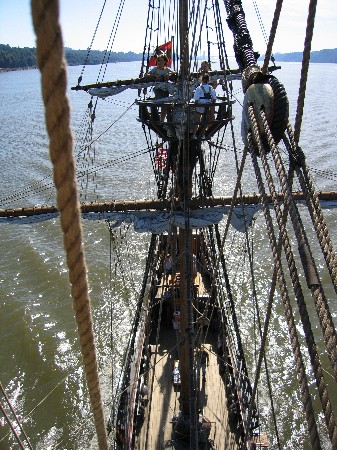
|
Before they know it, climbers can
find themselves standing more than six stories above the water, taking
in breathtaking views of the Hudson River Valley as they help work the
topsails or furl the sails (lashing them when they're not being used so
the wind can't grab them). |
|
Back to Top...
|
| Craftworks
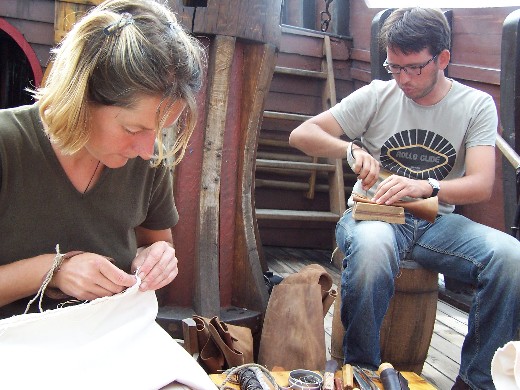
The Half Moon also requires
constant upkeep to keep her sailing smoothly. In their off-hours, the
crewmembers often grab needle and thread to make and repair various
tools for use around the ship, just as Hudson's crew would have done.

Here, several crewmembers are making sturdy
canvas buckets. Once they're complete, we can use these buckets to draw water from the river for deck washes or tie them to a running line
and use them to quickly send tools, water, or other supplies up to
crewmembers working in the tops.
|
| Leathercraft also comes in handy.
Here, Thanasi helps create a new sheath for a work knife. Once he
finishes sewing this seam shut, he'll insert the knife and soak the
sheath in water overnight. This shrinks and hardens the leather,
fitting it to the knife's shape.
The leather straps you see the crew wearing on
their hands are called palms. They work like thimbles, helping
the crew comfortably push a needle through heavy material.
|
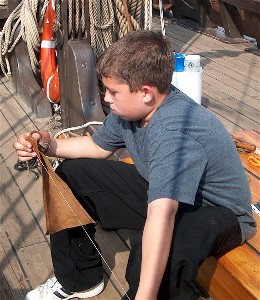
|
|
Back to Top...
|
| Music

Of course, it isn't all hard work onboard the Half
Moon. Just for fun, the crew joins in sing-alongs of a selection
of sea shanties, including crew favorites like Drunken Sailor and
John Kanaka. In the age of sailing ships, work songs like these
helped coordinate crews while they performed complex tasks, such as
working the capstan.
On this voyage, we were also treated to the
presence of two full-fledged musicians, Mr. Zantkuijl and Mr. Weisse,
who treated us to still more traditional tunes, such as the Dutch
national anthem.
Back to Top...
|
|
|